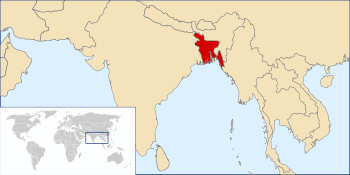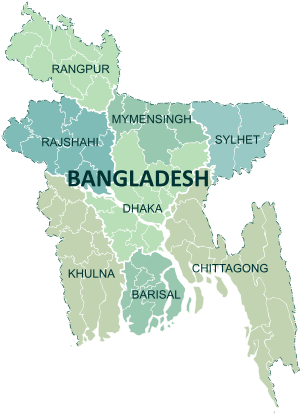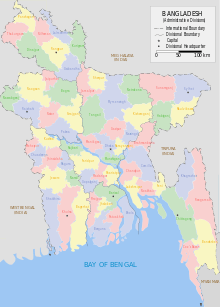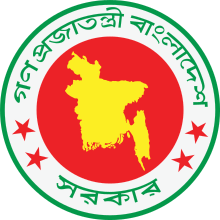Administrative geography of Bangladesh
Bangladesh is divided into 8 Divisions (Bibhag) and 64 Districts (Jela, Zila, Zela), although these have only a limited role in public policy. For the purposes of local government, the country is divided into Upazila (sub-districts), Municipalities, City Corporations and Union Councils (or rural councils). The diagram below outlines the five tiers of government in Bangladesh.
| 8 Divisions | |||||||||||||||||||||||||
| 64 Districts | |||||||||||||||||||||||||
| 492 Sub-Districts | |||||||||||||||||||||||||
| 4,554 Union Councils (Rural area) | 327 Municipalities (Suburb) | 12 City Corporations (Metropolis) | |||||||||||||||||||||||
| Villages | Wards | ||||||||||||||||||||||||
| Subdivisions of Bangladesh বাংলাদেশের প্রশাসনিক অঞ্চল | |||||||||||||||
|---|---|---|---|---|---|---|---|---|---|---|---|---|---|---|---|
 | |||||||||||||||
| Location | Bangladesh | ||||||||||||||
| Subdivisions | [1]
| ||||||||||||||
 |
|---|
| This article is part of a series on the politics and government of Bangladesh |
|
Constitution and law
|
|
Government |
|
|
|
|
|
Regions
Traditionally Bangladesh is divided between four regions by the fertile Ganges-Brahmaputra delta;[2] formed by the confluence of the Ganges (local name Padma or Pôdda), Brahmaputra (Jamuna or Jomuna), and Meghna rivers and their respective tributaries.
- Northern Bengal: comprising Rajshahi Division and Rangpur Division.[3]
- Eastern Bengal:[4] also known as eastern Bangladesh, comprising Chittagong Division,[5] Sylhet Division[6] and proposed Comilla Division,[7] known for the Surma-Meghna River System.[8]
- Central Bengal: also known as Central Bengal Region,[4] comprising Mymensingh Division and Dhaka Division, excluding proposed Faridpur Division.[9]
- Southern Bengal: comprising Barisal Division, Khulna Division and proposed Faridpur Division.[10]
Divisions

Bangladesh is divided into eight major administrative divisions (Bengali: বিভাগ Bibhag). Each division is named after the major city within its jurisdiction that serves as the administrative capital of that division:
- Barishal (বরিশাল Barishal)
- Chittagong (চট্টগ্রাম Chittagong)
- Dhaka (ঢাকা Dhaka)
- Mymensingh (ময়মনসিংহ Mymensingh)
- Khulna (খুলনা Khulna)
- Rajshahi (রাজশাহী Rajshahi)
- Rangpur (রংপুর Rangpur)
- Sylhet (সিলেট Sylhet)
Proposed divisions
- Comilla Division – proposed to consist six northwestern districts of the existing Chittagong Division, formerly known as Comilla Region.
- Faridpur Division – proposed to consist five southern districts of the existing Dhaka Division.
Districts

The divisions are divided into 64[11] districts, or zila (Bengali: জেলা, romanized: jela). Each district is run by a Deputy Commissioner (popularly abbreviated to "DC") who is appointed by the government from a Deputy secretary of BCS Administration Cadre.
| Division | Districts | Name of Districts |
|---|---|---|
| Barisal | 6 | Barguna, Barisal, Bhola, Jhalokati, Patuakhali, Pirojpur |
| Chittagong | 11 | Bandarban, Brahmanbaria, Chandpur, Chittagong, Comilla, Cox's Bazar, Feni, Khagrachari, Lakshmipur, Noakhali, Rangamati |
| Dhaka | 13 | Dhaka, Faridpur, Gazipur, Gopalganj, Kishoreganj, Madaripur, Manikganj, Munshiganj, Narayanganj, Narsingdi, Rajbari, Shariatpur, Tangail |
| Khulna | 10 | Bagerhat, Chuadanga, Jessore, Jhenaidah, Khulna, Kushtia, Magura, Meherpur, Narail, Satkhira |
| Mymensingh | 4 | Jamalpur, Mymensingh, Netrokona, Sherpur |
| Rajshahi | 8 | Bogra, Jaipurhat, Naogaon, Natore, Nawabganj, Pabna, Rajshahi, Sirajganj |
| Rangpur | 8 | Dinajpur, Gaibandha, Kurigram, Lalmonirhat, Nilphamari, Panchagarh, Rangpur, Thakurgaon |
| Sylhet | 4 | Habiganj, Moulvibazar, Sunamganj, Sylhet |
Upazilas

The districts are divided into sub-districts called Upazila (Bengali: উপজেলা, romanized: upojela). Upazilas are similar to the county subdivisions found in some Western countries. Bangladesh has 491 upazilas (as of 9 January 2017).[12][13] The upazilas are the second lowest tier of regional administration in Bangladesh. The administrative structure consists in fact in Divisions (8), Districts (64) and Upazila (491).
Upazilas were formerly known as thana which literally means police station. Despite the meaning, thanas functioned much as an administrative and geographic region, much as today's upazilas. In 1982 thanas were re-termed to as upazilas with provisions for semi-autonomous local governance. This system was reverted to the thana system in 1992. Later in 1999 geographic regions under administrations of thanas were converted into upazilas.[14] All administrative terms in this level were renamed from thana to upazila. For instance, Thana Nirbahi Officer (lit. Thana Executive Officer) was renamed to upazila Nirbahi Officer (lit. Upazila Executive Officer). The word thana is now used to solely refer to police stations. Generally, there is one police station for each upazila; but larger administrative units may have more than one police station covering different regions.
The Upazila is administered by Upazila Nirbahi Officer (UNO) and Upazila Parishad. UNOs are Senior Assistant Secretary of Bangladesh Civil Service (BCS). Each Upazila Parishad (or council) has a chairman, a vice-chairman and a woman vice-chairman. All three are elected through direct popular election.
The Sub-districts are further subdivided into 4,554 Rural Councils and 323 Town Councils or Paurasabha or Municipality.
Rural Blocks, Cities and Towns
City Corporations
The cities with a city corporation, having mayoral elections, include Dhaka South, Dhaka North, Chittagong, Khulna, Sylhet, Rajshahi, Barisal, Rangpur, Comilla, Narayanganj, Mymensingh and Gazipur. The city corporation are divided into wards, which are further divided into mahallas. Direct elections are held for each ward, electing a councillor. The city mayors are elected for a span of five years.
Municipal Corporations
In the metropolitan areas, excluding the cities with city corporations, have municipal corporations, also known as Paurasabha. Paurasabhas are divided into wards, which are further divided into Mauzas and Mahallas. Direct elections are held for each ward, electing a chairperson and a number of members. The municipal heads are elected for a span of five years.
Union Councils
Union Councils (or Union Parishads or Unions) are the smallest rural administrative and local government units in Bangladesh.[15] Each Union is made up of nine Wards. Usually one village is designated as a Ward. There are 4,553 Unions in Bangladesh.[1] A Union Council consists of a chairman and twelve members including three members exclusively reserved for women. Union Parishads are formed under the Local Government (Union Parishads) Act, 2009.[16] The boundary of each Union is demarcated by the Deputy Commissioner of the District. A Union Council is the body primarily responsible for agricultural, industrial and community development within the local limits of the union.
Lowest level elective units
Rural villages
City and municipal wards
Non–elective ceremonial units
Mahallas
Mouzas
See also
References
- http://www.bangladesh.gov.bd/?q=en
- Khan, Showkat Hayat (1999). United They Survive: Redistribution, Leadership, and Human Services Delivery in Rural Bangladesh. ISBN 9780739100509.
- https://www.files.ethz.ch/isn/146582/North%20Bengal%20report.pdf
- Haque, C. E. (6 December 2012). Hazards in a Fickle Environment: Bangladesh. ISBN 9789401151559.
- "Missionaries, martyrs and 500 years of faith in Bangladesh - La Croix International". international.la-croix.com.
- "Elephants in a reserve forest along India-Bangladesh border struggle for survival". Mongabay-India. 19 February 2019.
- "13 dead as truck crashes into workers' huts in Bangladesh". News24. 25 January 2019.
- "Bangladesh sets sights on recruitment brokers to curb abuse, trafficking". The Daily Star. 12 February 2019.
- Khan, Akbar Ali (1996). Discovery of Bangladesh: Explorations into dynamics of a hidden nation. ISBN 9789840513710.
- Das, Tulshi Kumar (29 December 2017). Social Structure and Cultural Practices in Slums: A Study of Slums in Dhaka City. Northern Book Centre. ISBN 9788172111106 – via Google Books.
- http://www.bangladesh.gov.bd/index.php?option=com_content&task=view&id=225&Itemid=272
- "upazila List". Bangladesh National Portal.
- "New upazila to be formed in Comilla". NTV. 9 January 2017. Retrieved 20 June 2017.
- AMM Shawkat Ali (2012). "Thana". In Sirajul Islam and Ahmed A. Jamal (ed.). Banglapedia: National Encyclopedia of Bangladesh (Second ed.). Asiatic Society of Bangladesh.
- Khan, Dr. Mohammad Mohabbat. "Functioning of Local Government (Union Parishad): Legal and Practical Constraints" (PDF). Democracywatch. Archived from the original (PDF) on 17 April 2018. Retrieved 24 March 2012.
- "Local Government (Union Parishads) Act, 2009 (in Bangla)". Bangladesh Code. Ministry of Law, Government of Bangladesh.

